The Virtus - Field Trial Report
- Lewis Stevens
- Case Studies
- 20 Oct 2021
-
85views

Read how Amy was helped with the Virtus Dynamic Seating System.
FIELD TRIAL PROCESS
With the Virtus Seating System coming out of development in the summer of 2020, RMS wanted to take this new product out into a real-life environment to gather first hand data on the clinical benefits of the seat unit.
Fortunately, we were made aware of a 10-year-old girl called Amy who was struggling with her current seating system. We approached the parents and therapists who were on board with us using Amy's case to see if the Virtus could provide her with a better seating situation.
This report is split into three main sections:
- Firstly, a brief description of Amy and her requirements, a look at her current equipment and what we were trying to achieve with the Virtus:
- Next is a description of work carried out and the observed benefits after six weeks. three months and six months:
- Finally, overviews from our in-house Product Specialist, the local school area Occupational Therapist and the Occupational Therapy Assistant who is in the classroom with Amy on a daily basis.
REPORT CONTRIBUTORS
CONDUCTED ON BEHALF OF RMS
Martin Rennie, BSc Occupational Therapy, RMS Product Specialist for Scotland.
WITH SPECIAL ASSISTANCE FROM
Debbie White, Children and Young People's Occupational Therapy LEad, Dundee.
AND VALUABLE FEEDBACK FROM
Eleanor Black, Occupational Therapy Assisstant taking daily care of Amy.
INTRODUCING AMY
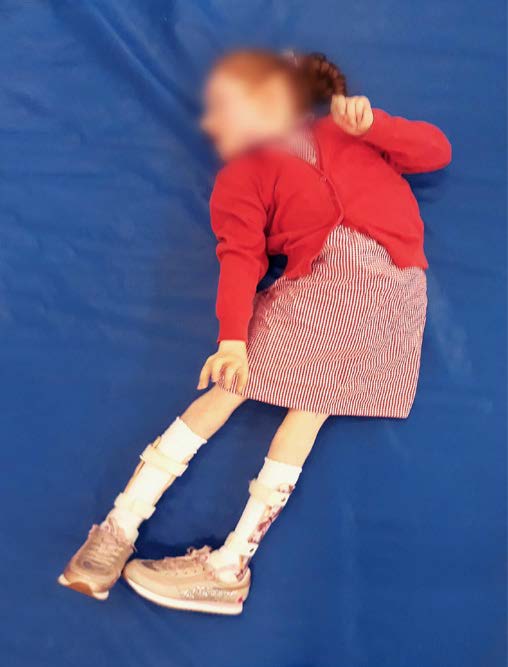

DIAGNOSIS
- Mixed Quadriplegic C.P - GMFCS Level 5
- Strong ATNR to RHS (Picture on left)
- Profound learning disability + sensory neural deficit.
- Visual impairment/ Cochlea implants.
SITUATION
Amy extends and rotates in all positions. Previous seating systems would support her initially but as Amy actively extends and rotates, her position would begin to deteriorate.
This resulted in reduced tolerance to seating, at times extreme distress, reduced ability to access her curriculum and increased concerns about safety during assisted feeding.
EQUIPMENT GOALS
PREVIOUS EQUIPMENT & SEATING TOLERANCE
- Seated in a widely used school system (Picture on right)
- Up to 1 hour in small sessions throughout the day.
VIRTUS SHORT TERM GOALS
- Stabilise her pelvis and promote a symmetrical seated position, while accommodating fluctuating tone.
VIRTUS LONG TERM GOALS
- Increase her tolerance of a seated position in order to access curriculum and school occupations. Achieve and maintain a seated position that will promote better and safer oral feeding.
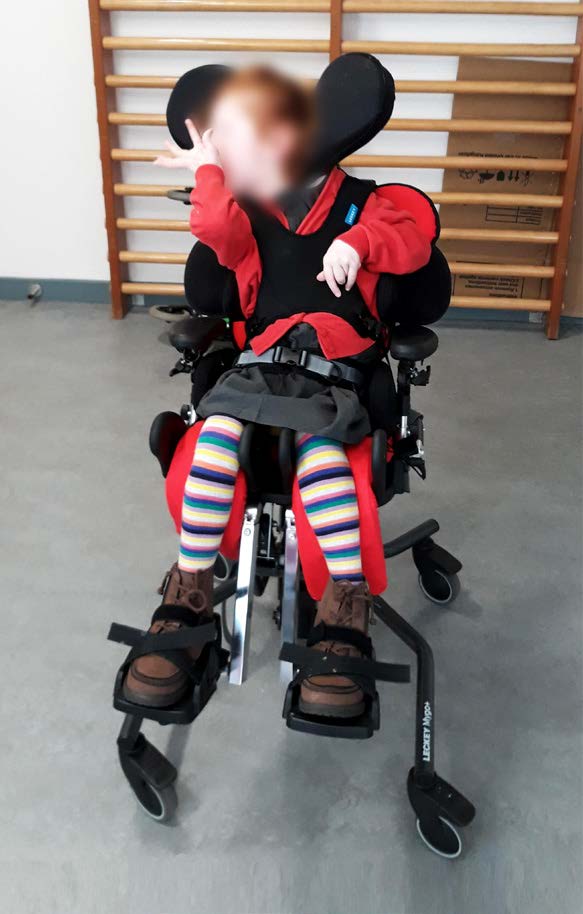

SIX WEEK REVIEW
POSITIONING
- Amy sat well in the Virtus. The IT shelf in the seat cushion has positively stabilised her pelvis and has a promoted and enabled a much more symmetrical position.
- Amy was taking weight equally through both lower limbs and was evenly bearing weight through both feet.
- The dynamic back rest in combination with the dynamic footplate is working well in absorbing Amy's tone on extension and there is minimal rotation through the trunk and pelvic on extension.
- Both the pelvic belt and trunk harness are sizes appropriately and are supporting Amy as expected.
- The Type G head support is working well in allowing Amy's head to rotate to the RHS on extension, but return to midline at rest.
FUNCTION
- It was reported by class staff that Amy is tolerating the Virtus significantly more than her old class chair, spending up to 2 hours in the Virtus over the course of a school day and she is requiring less time in side lying (Picture below)
- Class staff further reported that orally feeding Amy in the chair is easier with less effort required from staff to facilitate.
- It was reported that transfers in/ out of the chair were easier with the flip down pommel and swing away laterals.
ADJUSTMENTS MADE
- Head rest position was reviewed and adjusted to promote chin position and easier swallowing.
- LSP hip guide adjust to midline.
ADDITIONAL ACCESSORIES REQUIRED
- Footsures fitted after the first two weeks in order to stabilise foot positioning.
SEATING TOLERANCE
- Up to 2 hour spread throughout the day.
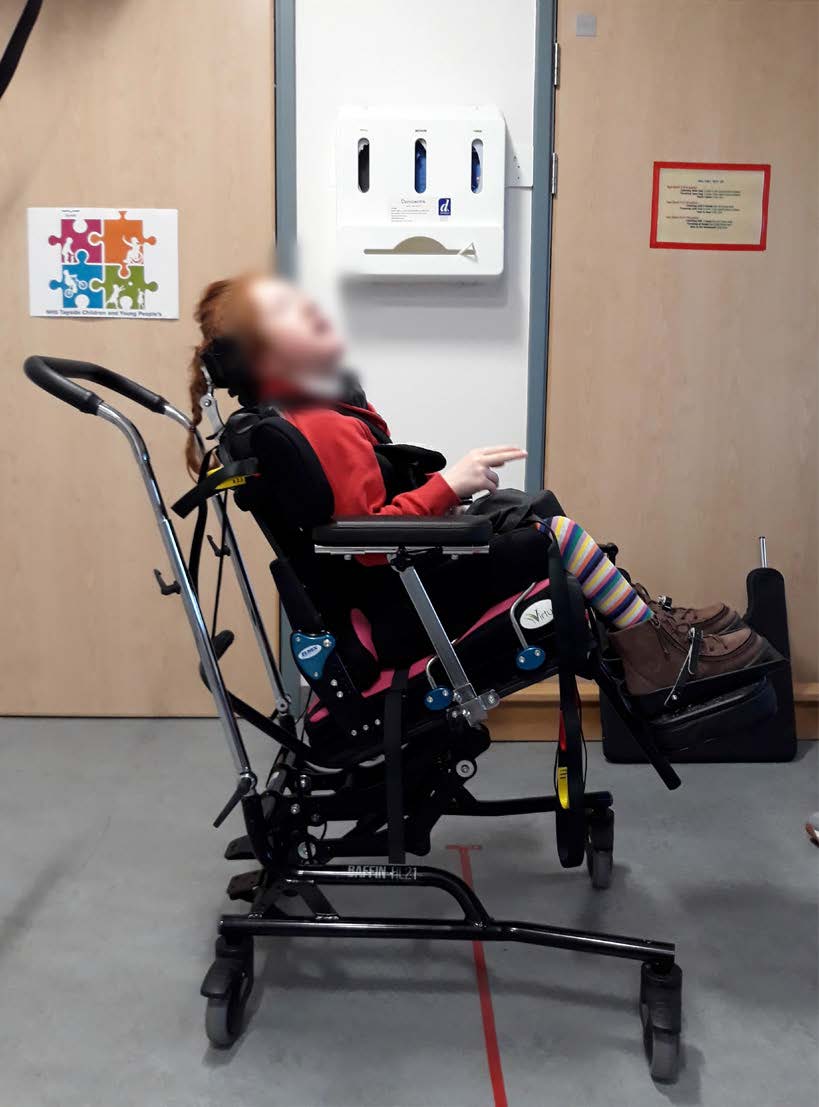

THREE MONTH REVIEW
POSITIONING
- Amy continues to sit well in the Virtus. The combination of the dynamic back and dynamic footplate are working effectively to stabilise the pelvis and the addition of footsures have promoted better alignment and positioning of the lower limbs.
- The Type G headrest is working well to support Amy's head while allowing rotation to the RHS during ATNR pattern presentation. A larger Type G head support to be supplied in order to further support head positioning.
FUNCTION
- Class staff report the Amy is tolerating the Virtus for up to 45 mins three times per day. This is significantly more than with previous seating systems.
- Feeding Amy orally continues to be going well and the staff like the larger padded tray for this activity.
ADJUSTMENTS MADE
- Adjusted the thoracic laterals and opened up RHS of head rest.
- Adjusted footsures and pelvic guides.
ADDITIONAL ACCESSORIES REQUIRED
- New pommel bracketry to be replaced under warranty.
- Large Type G headrest.
SEATING TOLERANCE
- Up to 3 hours spread throughout the day in larger extended chunks.
SIX MONTH REVIEW
POSITIONING
- The Virtus continues to support and accommodate Amy well. The chair consistentley promotes a more midline and symmetrical position and Amy's pelvis is stable and well supported.
- The larger Type G headrest has worked well in accommodating the ATNR pattern, while promoting a good chin position for feeding. It also helped in maintaining the position of Amy's head.
FUNCTION
- Amy is able to sit in the Virtus for as long as the class activities and curriculum requires and remains comfortable and well supported.
- Participation in class activities has increased and the task of feeding Amy continues to go well.
- Transfers in and out of the chair present no difficulties.
ADJUSTMENTS MADE
- Adjusted for width growth across pelvis and thoracic laterals.
ADDITIONAL ACCESSORIES REQUIRED
- New style sandals were fitted as staff reported the straps on the footsures were not holding the feet in place.
SEATING TOLERANCE
- Up to 3 hours spread throughout the day in larger extended chunks.
PRODUCT FEEDBACK
MARTIN RENNIE - RMS OCCUPATIONAL THERAPIST
To achieve the therapeutic goals of stabilising the pelvis and promoting a more symmetrical seated position, the Virtus chair was configured with additional ramping on the seat cushion and a dynamic backrest and footplate.
During episodes of ATNR presentation, the dynamic elements of the chair worked in conjunction with the ramped cushion, to effectively stabilise the pelvis. The Type G headrest allowed Amy's head to rotate round the RHS, before returning back to a more midline position. (Picture on right)
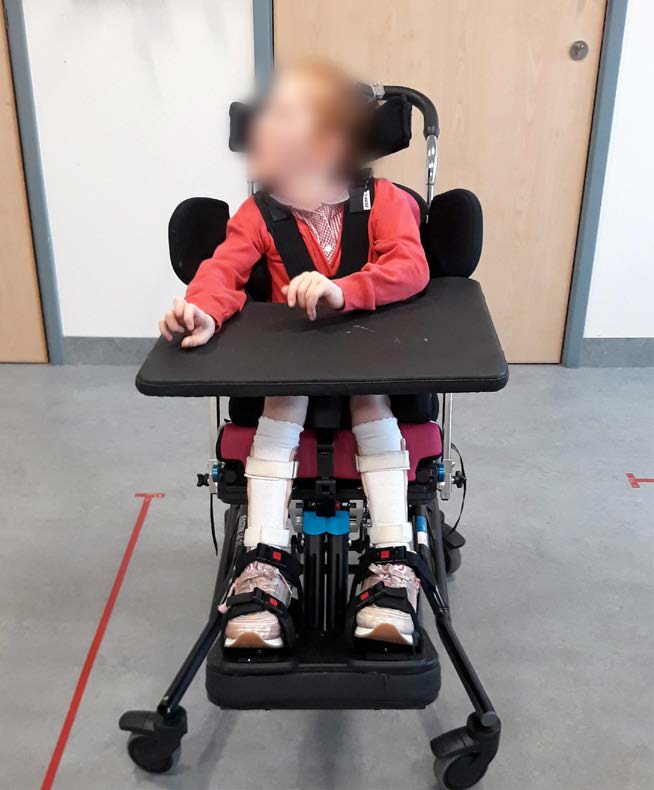

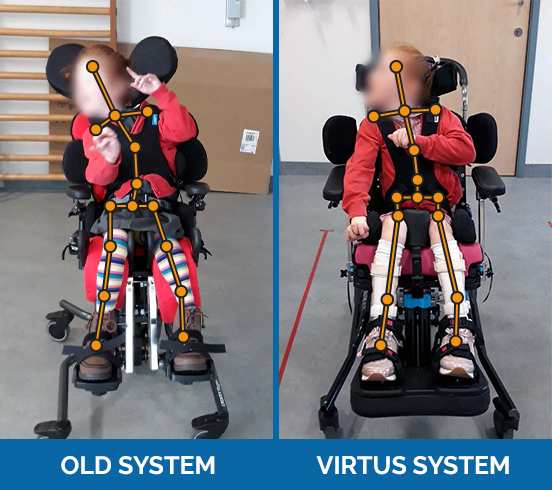

Over the duration of this trial, Amy consistently presented with a more symmetrical and midline position. In her previous seating-system she presented with a rotated and oblique pelvis. In the Virtus, the pelvis remained neutral, and her spine was less rotated. Amy's shoulders were more horizontal, and she was taking appropriate support from the backrest cushion. (Picture on left)
As Amy was better supported and positioned in the Virtus, she was able to build up her tolerance of being in an upright seated position from less than 1 hour over the course of the school day, to up to 3 hours. It was visibly noticeable how much more relaxed Amy is when using the Virtus and she was able to participate in class activities and access more of the curriculum.
Orally feeding Amy became easier due to the improved support and positioning provided by the Virtus, combined with the head position achieved with the Type G head support. The class staff reported that feeding Amy in the Virtus required only one member of staff rather than two members of staff that were required with the previous seating system. (Picture on right)
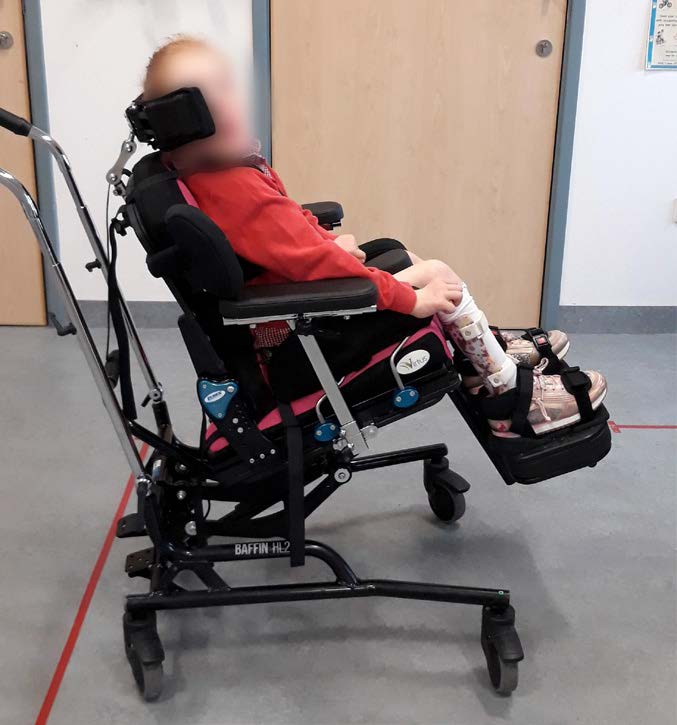

DEBBIE WHITE - OCCUPATIONAL THERAPY LEAD
With Amy's previous seating system class staff regularly contacted Occupational Therapy to re-assess/ review and adjust seating. Our goal going into this trial was to achieve pelvic stability and best possible symmetry to enable Amy's comfort, tolerance, safety in feeding, and access to her curriculum.
Discussion about the above concerns were discussed with Martin during an assessment of Amy, and he suggested that we considered the functions of the Virtus to offer maximum support, positioning options and dynamic elements not previously possible in other seating options we that were tried. We were excited to go ahead with the trial, as were Amy's parents.
Over the trial period we were able to continuously assess how each change impacted on Amy's positioning over time. Where before we were getting regular negative feedback, since having the Virtus it has been noted that there have been no concerns highlighted to us from signs of distress in seating, and requires less assistance during feeding from an adult. Both parents and ourselves are satisfied that the Virtus best meets Amy's needs.
Following the success of this trial we have had initial discussions with Amy's parents and our wheelchair service about providing a base that is this Virtus could be interfaced to, so that she has a single seat for mobility and school use.
Learning from this trial of the Virtus has led to two further assessments with other children where other seating systems have not best met their specific needs.
ELEANOR BLACK - OCCUPATIONAL THERAPY ASSISTANT
Amy struggled when seated in her previous system and class staff were constantly asking for her seating to be reviewed. She would tolerate very short spells in the chair and only use her old chair for feeding. Again, this was difficult as staff has to safely manually position her head while trying to feed her at the same time.
Amy was becoming increasingly upset when using her old seating system and this agitation then crossed over when using other items of equipment. This was having an impact on her 24hour postural management and she was spending more time in side lying or on a mat on the floor.
Since being issued with the Virtus, class staff have reported that Amy can tolerate being seated for long periods of time. She is happy and relaxed in the chair and is able to engage in activities with her peers. This has had a huge impact on her feeding and her calorie intake has increased which has helped improve her mood.
The class staff have reported that they are less stressed as Amy is no longer upset for long periods of the day and they have described the Virtus as "brilliant".
